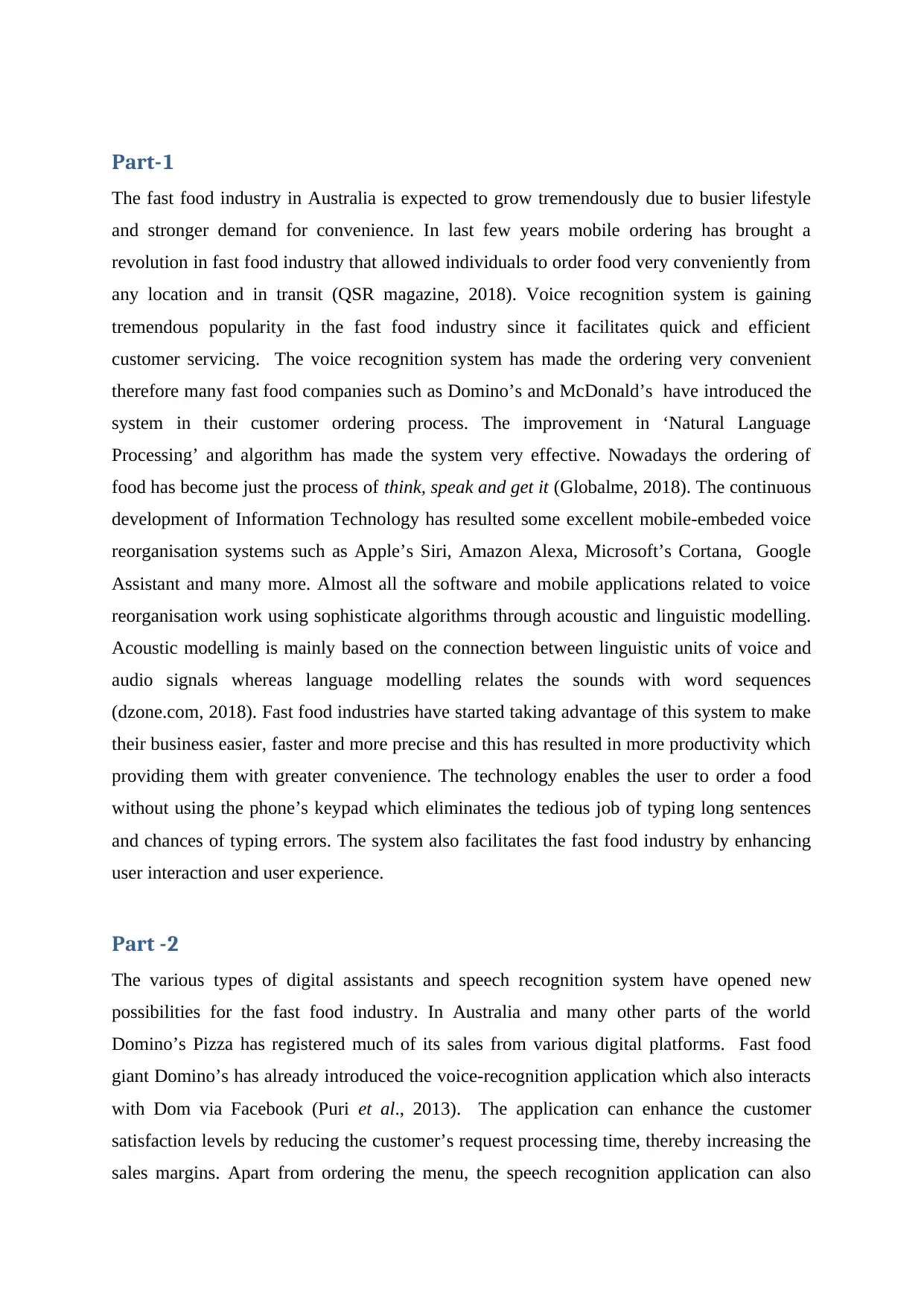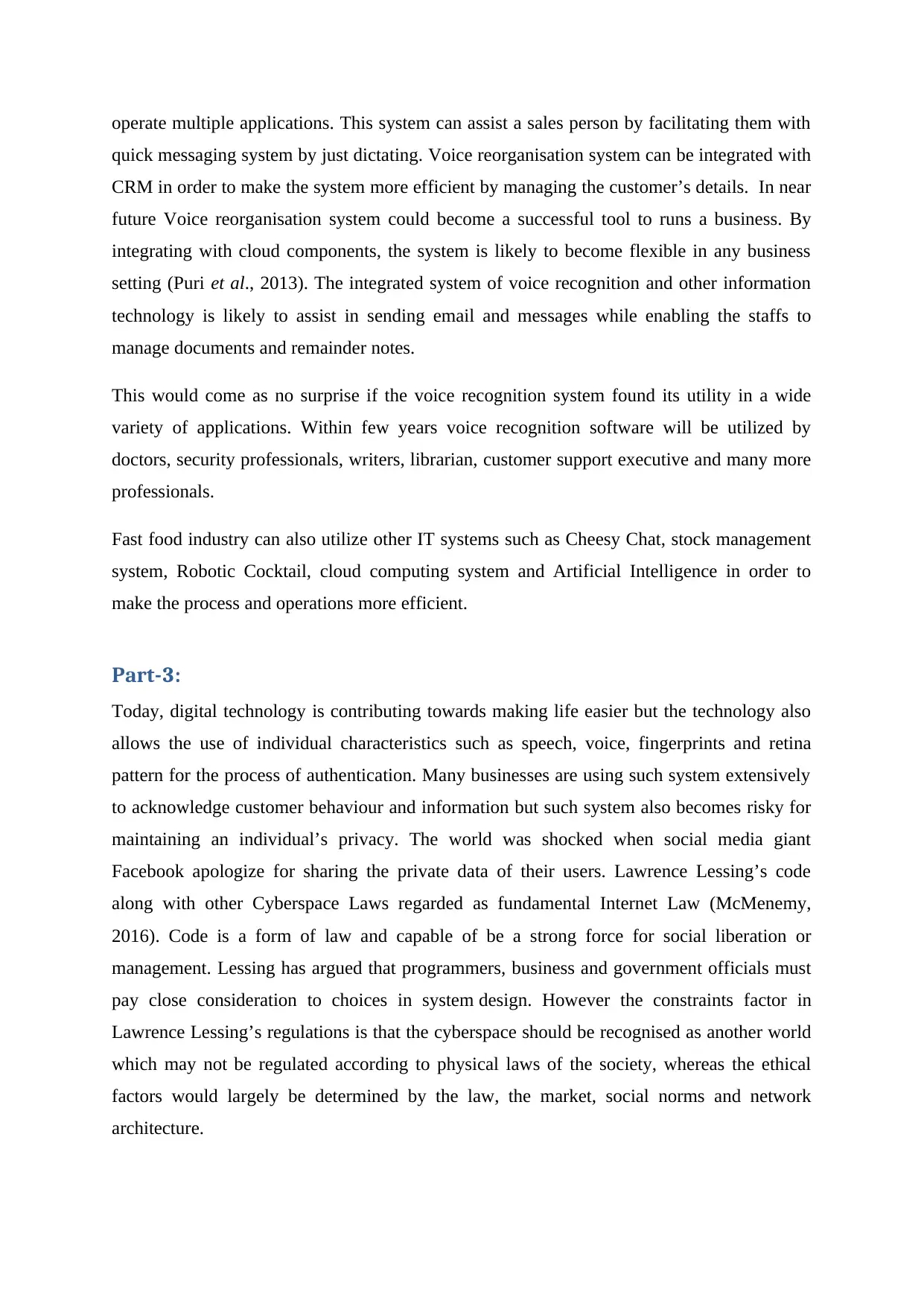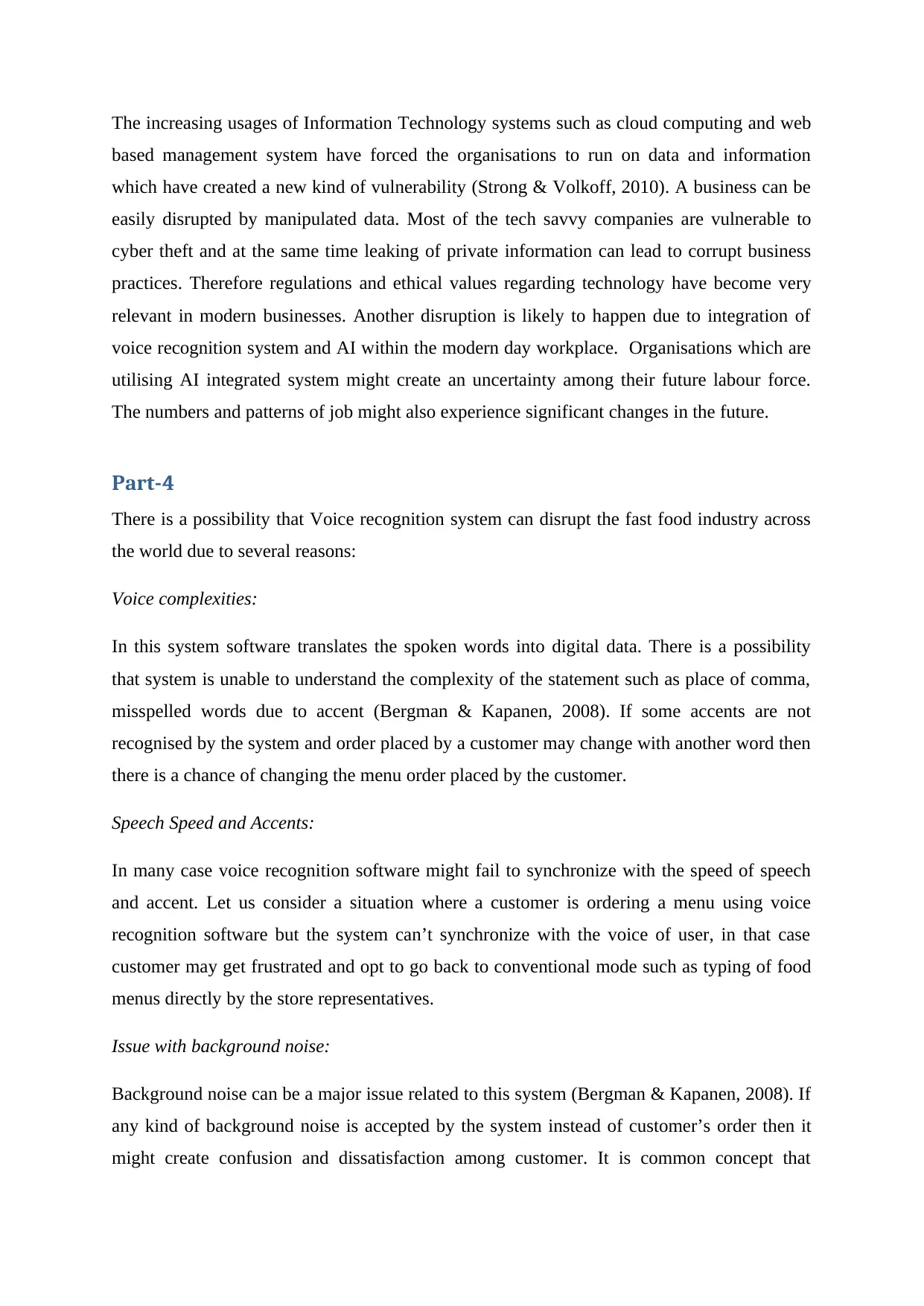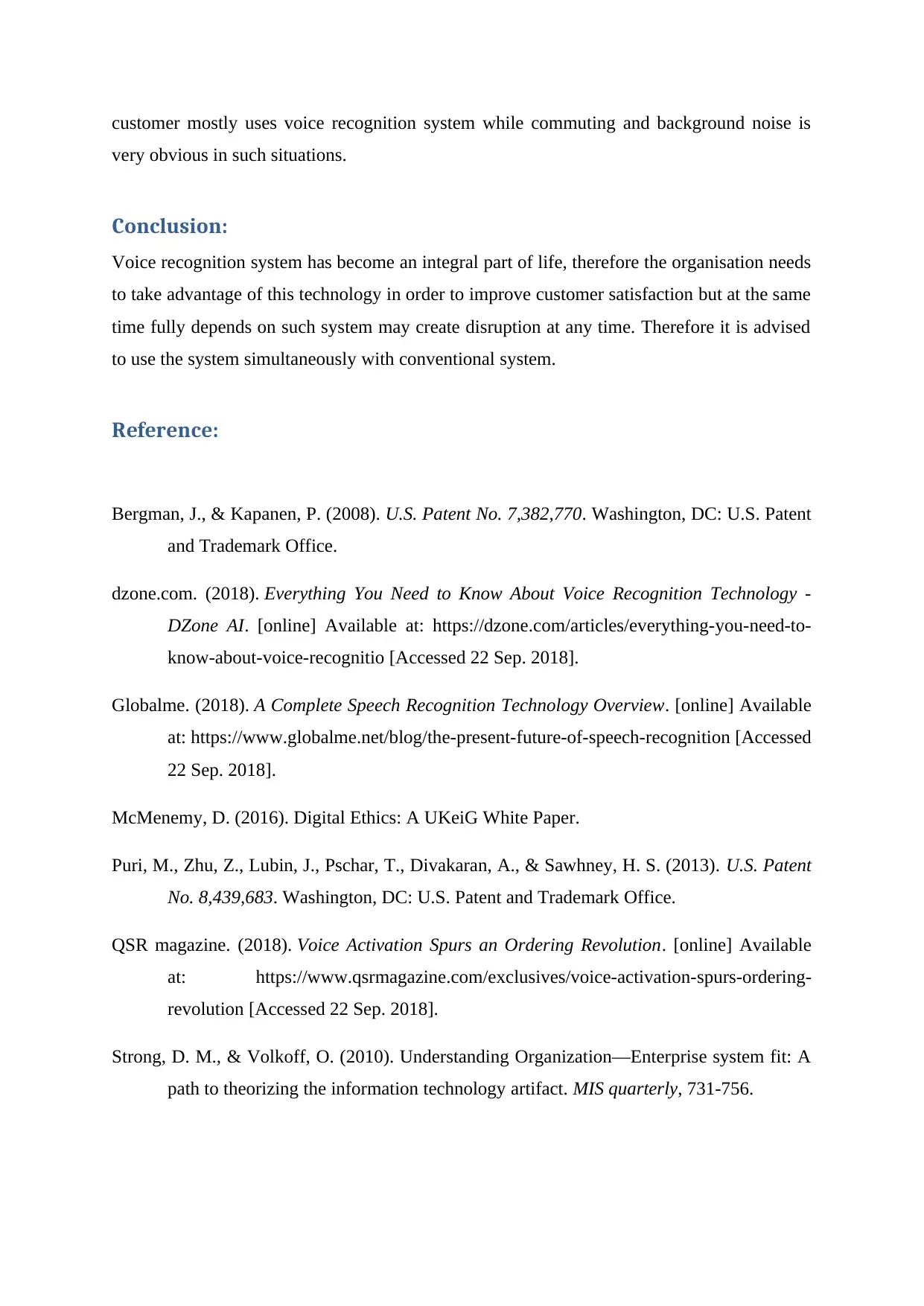The Digital Revolution: Voice Recognition in the Fast Food Industry
VerifiedAdded on 2023/06/05
|7
|1549
|476
Report
AI Summary
This report examines the profound impact of voice recognition systems on the fast food industry, focusing on the Australian market's growth driven by convenience and mobile ordering. It details the increasing adoption of voice recognition technologies like Siri, Alexa, and Google Assistant, highlighting their role in enhancing customer service and streamlining operations through improved natural language processing. The report explores various applications, including Domino's Pizza's implementation, and discusses integration with CRM systems. It also addresses potential disruptions related to voice complexities, speech speed, accents, and background noise, as well as ethical considerations concerning data privacy and job displacement. The conclusion recommends a balanced approach, integrating voice recognition with conventional systems to optimize customer satisfaction and mitigate risks. The report references relevant articles and patents to support its findings.

Understanding the Digital Revolution
The potential impact of voice recognition system on Fast Food Industry
The potential impact of voice recognition system on Fast Food Industry
Paraphrase This Document
Need a fresh take? Get an instant paraphrase of this document with our AI Paraphraser

Table of Contents
Part-1..........................................................................................................................................3
Part -2.........................................................................................................................................3
Part-3:.........................................................................................................................................4
Part-4..........................................................................................................................................5
Conclusion:................................................................................................................................5
Part-1..........................................................................................................................................3
Part -2.........................................................................................................................................3
Part-3:.........................................................................................................................................4
Part-4..........................................................................................................................................5
Conclusion:................................................................................................................................5

Part-1
The fast food industry in Australia is expected to grow tremendously due to busier lifestyle
and stronger demand for convenience. In last few years mobile ordering has brought a
revolution in fast food industry that allowed individuals to order food very conveniently from
any location and in transit (QSR magazine, 2018). Voice recognition system is gaining
tremendous popularity in the fast food industry since it facilitates quick and efficient
customer servicing. The voice recognition system has made the ordering very convenient
therefore many fast food companies such as Domino’s and McDonald’s have introduced the
system in their customer ordering process. The improvement in ‘Natural Language
Processing’ and algorithm has made the system very effective. Nowadays the ordering of
food has become just the process of think, speak and get it (Globalme, 2018). The continuous
development of Information Technology has resulted some excellent mobile-embeded voice
reorganisation systems such as Apple’s Siri, Amazon Alexa, Microsoft’s Cortana, Google
Assistant and many more. Almost all the software and mobile applications related to voice
reorganisation work using sophisticate algorithms through acoustic and linguistic modelling.
Acoustic modelling is mainly based on the connection between linguistic units of voice and
audio signals whereas language modelling relates the sounds with word sequences
(dzone.com, 2018). Fast food industries have started taking advantage of this system to make
their business easier, faster and more precise and this has resulted in more productivity which
providing them with greater convenience. The technology enables the user to order a food
without using the phone’s keypad which eliminates the tedious job of typing long sentences
and chances of typing errors. The system also facilitates the fast food industry by enhancing
user interaction and user experience.
Part -2
The various types of digital assistants and speech recognition system have opened new
possibilities for the fast food industry. In Australia and many other parts of the world
Domino’s Pizza has registered much of its sales from various digital platforms. Fast food
giant Domino’s has already introduced the voice-recognition application which also interacts
with Dom via Facebook (Puri et al., 2013). The application can enhance the customer
satisfaction levels by reducing the customer’s request processing time, thereby increasing the
sales margins. Apart from ordering the menu, the speech recognition application can also
The fast food industry in Australia is expected to grow tremendously due to busier lifestyle
and stronger demand for convenience. In last few years mobile ordering has brought a
revolution in fast food industry that allowed individuals to order food very conveniently from
any location and in transit (QSR magazine, 2018). Voice recognition system is gaining
tremendous popularity in the fast food industry since it facilitates quick and efficient
customer servicing. The voice recognition system has made the ordering very convenient
therefore many fast food companies such as Domino’s and McDonald’s have introduced the
system in their customer ordering process. The improvement in ‘Natural Language
Processing’ and algorithm has made the system very effective. Nowadays the ordering of
food has become just the process of think, speak and get it (Globalme, 2018). The continuous
development of Information Technology has resulted some excellent mobile-embeded voice
reorganisation systems such as Apple’s Siri, Amazon Alexa, Microsoft’s Cortana, Google
Assistant and many more. Almost all the software and mobile applications related to voice
reorganisation work using sophisticate algorithms through acoustic and linguistic modelling.
Acoustic modelling is mainly based on the connection between linguistic units of voice and
audio signals whereas language modelling relates the sounds with word sequences
(dzone.com, 2018). Fast food industries have started taking advantage of this system to make
their business easier, faster and more precise and this has resulted in more productivity which
providing them with greater convenience. The technology enables the user to order a food
without using the phone’s keypad which eliminates the tedious job of typing long sentences
and chances of typing errors. The system also facilitates the fast food industry by enhancing
user interaction and user experience.
Part -2
The various types of digital assistants and speech recognition system have opened new
possibilities for the fast food industry. In Australia and many other parts of the world
Domino’s Pizza has registered much of its sales from various digital platforms. Fast food
giant Domino’s has already introduced the voice-recognition application which also interacts
with Dom via Facebook (Puri et al., 2013). The application can enhance the customer
satisfaction levels by reducing the customer’s request processing time, thereby increasing the
sales margins. Apart from ordering the menu, the speech recognition application can also
⊘ This is a preview!⊘
Do you want full access?
Subscribe today to unlock all pages.

Trusted by 1+ million students worldwide

operate multiple applications. This system can assist a sales person by facilitating them with
quick messaging system by just dictating. Voice reorganisation system can be integrated with
CRM in order to make the system more efficient by managing the customer’s details. In near
future Voice reorganisation system could become a successful tool to runs a business. By
integrating with cloud components, the system is likely to become flexible in any business
setting (Puri et al., 2013). The integrated system of voice recognition and other information
technology is likely to assist in sending email and messages while enabling the staffs to
manage documents and remainder notes.
This would come as no surprise if the voice recognition system found its utility in a wide
variety of applications. Within few years voice recognition software will be utilized by
doctors, security professionals, writers, librarian, customer support executive and many more
professionals.
Fast food industry can also utilize other IT systems such as Cheesy Chat, stock management
system, Robotic Cocktail, cloud computing system and Artificial Intelligence in order to
make the process and operations more efficient.
Part-3:
Today, digital technology is contributing towards making life easier but the technology also
allows the use of individual characteristics such as speech, voice, fingerprints and retina
pattern for the process of authentication. Many businesses are using such system extensively
to acknowledge customer behaviour and information but such system also becomes risky for
maintaining an individual’s privacy. The world was shocked when social media giant
Facebook apologize for sharing the private data of their users. Lawrence Lessing’s code
along with other Cyberspace Laws regarded as fundamental Internet Law (McMenemy,
2016). Code is a form of law and capable of be a strong force for social liberation or
management. Lessing has argued that programmers, business and government officials must
pay close consideration to choices in system design. However the constraints factor in
Lawrence Lessing’s regulations is that the cyberspace should be recognised as another world
which may not be regulated according to physical laws of the society, whereas the ethical
factors would largely be determined by the law, the market, social norms and network
architecture.
quick messaging system by just dictating. Voice reorganisation system can be integrated with
CRM in order to make the system more efficient by managing the customer’s details. In near
future Voice reorganisation system could become a successful tool to runs a business. By
integrating with cloud components, the system is likely to become flexible in any business
setting (Puri et al., 2013). The integrated system of voice recognition and other information
technology is likely to assist in sending email and messages while enabling the staffs to
manage documents and remainder notes.
This would come as no surprise if the voice recognition system found its utility in a wide
variety of applications. Within few years voice recognition software will be utilized by
doctors, security professionals, writers, librarian, customer support executive and many more
professionals.
Fast food industry can also utilize other IT systems such as Cheesy Chat, stock management
system, Robotic Cocktail, cloud computing system and Artificial Intelligence in order to
make the process and operations more efficient.
Part-3:
Today, digital technology is contributing towards making life easier but the technology also
allows the use of individual characteristics such as speech, voice, fingerprints and retina
pattern for the process of authentication. Many businesses are using such system extensively
to acknowledge customer behaviour and information but such system also becomes risky for
maintaining an individual’s privacy. The world was shocked when social media giant
Facebook apologize for sharing the private data of their users. Lawrence Lessing’s code
along with other Cyberspace Laws regarded as fundamental Internet Law (McMenemy,
2016). Code is a form of law and capable of be a strong force for social liberation or
management. Lessing has argued that programmers, business and government officials must
pay close consideration to choices in system design. However the constraints factor in
Lawrence Lessing’s regulations is that the cyberspace should be recognised as another world
which may not be regulated according to physical laws of the society, whereas the ethical
factors would largely be determined by the law, the market, social norms and network
architecture.
Paraphrase This Document
Need a fresh take? Get an instant paraphrase of this document with our AI Paraphraser

The increasing usages of Information Technology systems such as cloud computing and web
based management system have forced the organisations to run on data and information
which have created a new kind of vulnerability (Strong & Volkoff, 2010). A business can be
easily disrupted by manipulated data. Most of the tech savvy companies are vulnerable to
cyber theft and at the same time leaking of private information can lead to corrupt business
practices. Therefore regulations and ethical values regarding technology have become very
relevant in modern businesses. Another disruption is likely to happen due to integration of
voice recognition system and AI within the modern day workplace. Organisations which are
utilising AI integrated system might create an uncertainty among their future labour force.
The numbers and patterns of job might also experience significant changes in the future.
Part-4
There is a possibility that Voice recognition system can disrupt the fast food industry across
the world due to several reasons:
Voice complexities:
In this system software translates the spoken words into digital data. There is a possibility
that system is unable to understand the complexity of the statement such as place of comma,
misspelled words due to accent (Bergman & Kapanen, 2008). If some accents are not
recognised by the system and order placed by a customer may change with another word then
there is a chance of changing the menu order placed by the customer.
Speech Speed and Accents:
In many case voice recognition software might fail to synchronize with the speed of speech
and accent. Let us consider a situation where a customer is ordering a menu using voice
recognition software but the system can’t synchronize with the voice of user, in that case
customer may get frustrated and opt to go back to conventional mode such as typing of food
menus directly by the store representatives.
Issue with background noise:
Background noise can be a major issue related to this system (Bergman & Kapanen, 2008). If
any kind of background noise is accepted by the system instead of customer’s order then it
might create confusion and dissatisfaction among customer. It is common concept that
based management system have forced the organisations to run on data and information
which have created a new kind of vulnerability (Strong & Volkoff, 2010). A business can be
easily disrupted by manipulated data. Most of the tech savvy companies are vulnerable to
cyber theft and at the same time leaking of private information can lead to corrupt business
practices. Therefore regulations and ethical values regarding technology have become very
relevant in modern businesses. Another disruption is likely to happen due to integration of
voice recognition system and AI within the modern day workplace. Organisations which are
utilising AI integrated system might create an uncertainty among their future labour force.
The numbers and patterns of job might also experience significant changes in the future.
Part-4
There is a possibility that Voice recognition system can disrupt the fast food industry across
the world due to several reasons:
Voice complexities:
In this system software translates the spoken words into digital data. There is a possibility
that system is unable to understand the complexity of the statement such as place of comma,
misspelled words due to accent (Bergman & Kapanen, 2008). If some accents are not
recognised by the system and order placed by a customer may change with another word then
there is a chance of changing the menu order placed by the customer.
Speech Speed and Accents:
In many case voice recognition software might fail to synchronize with the speed of speech
and accent. Let us consider a situation where a customer is ordering a menu using voice
recognition software but the system can’t synchronize with the voice of user, in that case
customer may get frustrated and opt to go back to conventional mode such as typing of food
menus directly by the store representatives.
Issue with background noise:
Background noise can be a major issue related to this system (Bergman & Kapanen, 2008). If
any kind of background noise is accepted by the system instead of customer’s order then it
might create confusion and dissatisfaction among customer. It is common concept that

customer mostly uses voice recognition system while commuting and background noise is
very obvious in such situations.
Conclusion:
Voice recognition system has become an integral part of life, therefore the organisation needs
to take advantage of this technology in order to improve customer satisfaction but at the same
time fully depends on such system may create disruption at any time. Therefore it is advised
to use the system simultaneously with conventional system.
Reference:
Bergman, J., & Kapanen, P. (2008). U.S. Patent No. 7,382,770. Washington, DC: U.S. Patent
and Trademark Office.
dzone.com. (2018). Everything You Need to Know About Voice Recognition Technology -
DZone AI. [online] Available at: https://dzone.com/articles/everything-you-need-to-
know-about-voice-recognitio [Accessed 22 Sep. 2018].
Globalme. (2018). A Complete Speech Recognition Technology Overview. [online] Available
at: https://www.globalme.net/blog/the-present-future-of-speech-recognition [Accessed
22 Sep. 2018].
McMenemy, D. (2016). Digital Ethics: A UKeiG White Paper.
Puri, M., Zhu, Z., Lubin, J., Pschar, T., Divakaran, A., & Sawhney, H. S. (2013). U.S. Patent
No. 8,439,683. Washington, DC: U.S. Patent and Trademark Office.
QSR magazine. (2018). Voice Activation Spurs an Ordering Revolution. [online] Available
at: https://www.qsrmagazine.com/exclusives/voice-activation-spurs-ordering-
revolution [Accessed 22 Sep. 2018].
Strong, D. M., & Volkoff, O. (2010). Understanding Organization—Enterprise system fit: A
path to theorizing the information technology artifact. MIS quarterly, 731-756.
very obvious in such situations.
Conclusion:
Voice recognition system has become an integral part of life, therefore the organisation needs
to take advantage of this technology in order to improve customer satisfaction but at the same
time fully depends on such system may create disruption at any time. Therefore it is advised
to use the system simultaneously with conventional system.
Reference:
Bergman, J., & Kapanen, P. (2008). U.S. Patent No. 7,382,770. Washington, DC: U.S. Patent
and Trademark Office.
dzone.com. (2018). Everything You Need to Know About Voice Recognition Technology -
DZone AI. [online] Available at: https://dzone.com/articles/everything-you-need-to-
know-about-voice-recognitio [Accessed 22 Sep. 2018].
Globalme. (2018). A Complete Speech Recognition Technology Overview. [online] Available
at: https://www.globalme.net/blog/the-present-future-of-speech-recognition [Accessed
22 Sep. 2018].
McMenemy, D. (2016). Digital Ethics: A UKeiG White Paper.
Puri, M., Zhu, Z., Lubin, J., Pschar, T., Divakaran, A., & Sawhney, H. S. (2013). U.S. Patent
No. 8,439,683. Washington, DC: U.S. Patent and Trademark Office.
QSR magazine. (2018). Voice Activation Spurs an Ordering Revolution. [online] Available
at: https://www.qsrmagazine.com/exclusives/voice-activation-spurs-ordering-
revolution [Accessed 22 Sep. 2018].
Strong, D. M., & Volkoff, O. (2010). Understanding Organization—Enterprise system fit: A
path to theorizing the information technology artifact. MIS quarterly, 731-756.
⊘ This is a preview!⊘
Do you want full access?
Subscribe today to unlock all pages.

Trusted by 1+ million students worldwide

1 out of 7
Your All-in-One AI-Powered Toolkit for Academic Success.
+13062052269
info@desklib.com
Available 24*7 on WhatsApp / Email
![[object Object]](/_next/static/media/star-bottom.7253800d.svg)
Unlock your academic potential
Copyright © 2020–2025 A2Z Services. All Rights Reserved. Developed and managed by ZUCOL.
